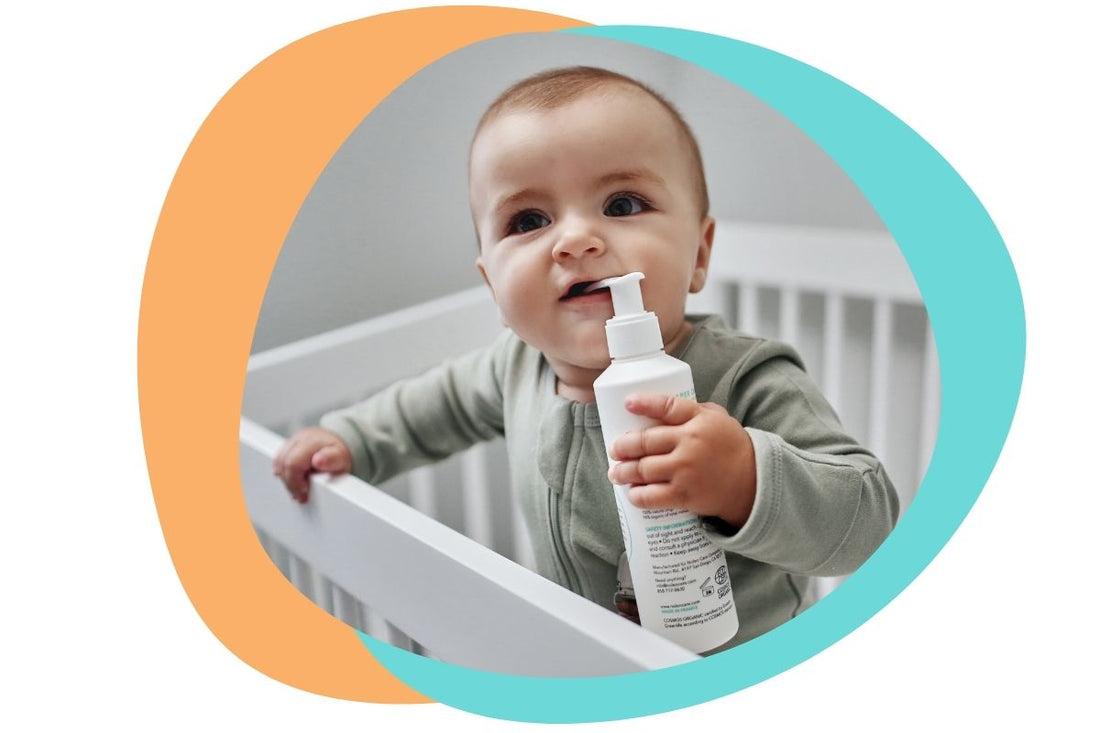
The Safest Remedies for Eczema in Babies
Share
If you’ve ever noticed dry, flaky, and red patches on your baby’s skin, you’re not alone. In fact, the American Academy of Dermatology estimates that eczema affects up to 25 percent of all children. While many little ones eventually outgrow their eczema and the condition is not contagious, the sight of dermatitis on their little one’s skin can still raise alarm. As of now, there is no cure for eczema. However, there are several ways to ease the irritating and painful symptoms and prevent future flare ups.
Avoid your baby’s triggers
Eczema flare ups typically happen when the skin is triggered by an internal or external source. There are three main categories of triggers:
- Triggers that come from the body, like sweat and saliva
- Environmental triggers, like smoke, pollen, pet dander, and a dry climate
- Product triggers, like detergents, lotions, and soaps that contain fragrance or other chemical irritants
The first step in treating your little one’s eczema should be identifying their triggers and removing them from their environment. For example, if you live in a dry climate, consider using a humidifier in your home. If someone in your family smokes, ask them not to do so around your child. Finally, it’s a good idea to check all of your current baby care products (wipes, lotions, etc.) for fragrances or potentially irritating ingredients. If you suspect a certain product is causing irritation, as fragranced and chemical-laden substances often do, switch to a gentle, natural alternative like NOLEO 3-in-1.
Take the proper steps during bath time
Bath time matters when caring for a baby’s eczema-prone skin as it cleanses their skin of dirt and potential irritants. However, try to bathe your baby only when necessary. Frequent baths can dry out their delicate skin and exacerbate eczema symptoms. When you do bathe your little one, limit their time in the tub to 10 minutes at the most. Wash with lukewarm water, use a mild, unfragranced soap, and be gentle with their skin (no harsh scrubbing!). Right after you remove them for the bath, apply a fragrance-free moisturizer while their skin is still damp.
Keep their skin hydrated
A good moisturizer is key to easing eczema symptoms and itchiness. You will want to find a thick moisturizer that hydrates well and is safe for their sensitive skin. In general, thicker creams and ointments moisturize better than lotions and oils. Avoid moisturizers with fragrance, sulfates, parabens, phenoxyethanol, and other harsh chemicals. Apply the moisturizer one to two times a day or as frequently as their skin needs.
While eczema doesn’t typically spread to the diaper area, babies with eczema-prone, sensitive skin can be more likely to develop diaper rash. To manage this, switch to a gentle diaper rash cream that cleanses and moisturizes the area like NOLEO 3-in-1.
Use eczema-safe products
Not sure which products are safe for your little one’s sensitive skin? The National Eczema Association awards certain products with their Seal of Acceptance™ if they are free of known irritants to eczema-prone and sensitive skin. NOLEO 3-in-1 Diaper Rash Cream was awarded with the NEA Seal of Acceptance™, thanks to our gentle formula. Keep in mind that you should always test a pea-sized amount of a new product on your baby’s skin before fully applying it. You can find the full list of products that have been granted the NEA Seal of Acceptance™ here.
Consider using a topical corticosteroid
Topical corticosteroids are medicated creams that help reduce the symptoms of an eczema flare up. If your child’s eczema symptoms are severe, your child’s pediatrician may prescribe a topical corticosteroid cream, ointment, lotion, or spray. Talk to your little one’s doctor about your options for treatment. If your baby is prescribed a topical corticosteroid, follow their application directions carefully to avoid further irritation and side effects.
Takeaway
Although doctors have not yet found a cure for eczema, you can still manage your little one’s symptoms at home or with the help of their doctors. Avoid triggers, keep their skin moisturized, and look for the NEA Seal of Acceptance™ when choosing irritant-free products for their sensitive skin.
Sources:
https://www.aad.org/public/diseases/eczema/childhood/treating/treat-babies
https://nationaleczema.org/eczema-products/about-nea-seal-of-acceptance/
